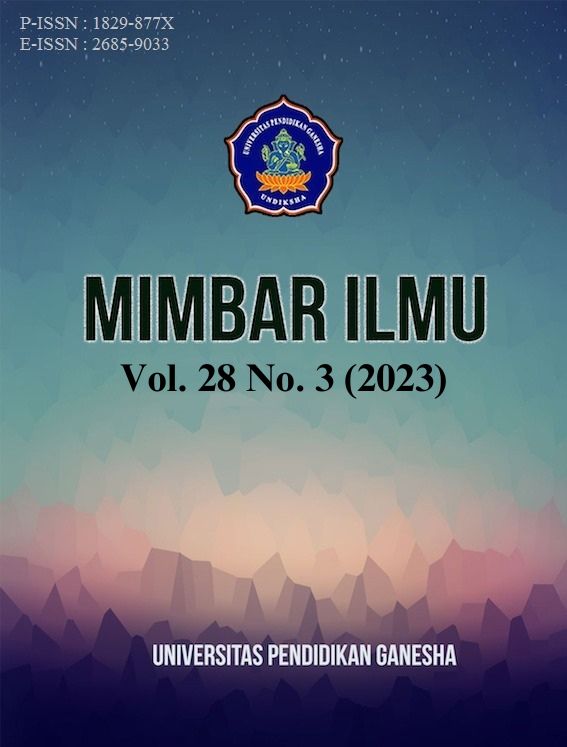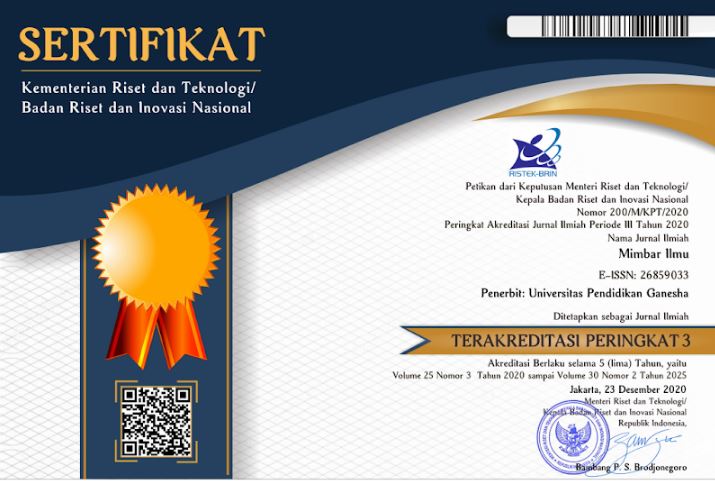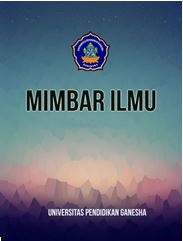Transactional Analysis Counseling to Improve Intercultural Communication of Tourism Vocational Students
DOI:
https://doi.org/10.23887/mi.v28i3.72034Keywords:
Transactional Analysis Counseling, Intercultural Communication, Tourism Vocational School studentsAbstract
Schools had never implemented special techniques in the implementation of Guidance and Counseling to develop students' intercultural communication at school. These problems cause failure in the communication process which can result in worsening social relations between students. The aim of this research is to analyze the differences in intercultural communication between Tourism Vocational School students before and after the transactional analysis counseling intervention. The research design used is a pretest posttest group design. The sampling technique in this research is purposive sampling, namely sampling based on the researcher's judgment. This research uses two types of instruments, namely: (1) transactional analysis counseling module treatment materials, and (2) data collection instruments in the form of an intercultural communication competency scale. The data collected in this research is then analyzed using the non-parametric Wilcoxon statistical test. To answer the hypothesis in this research, it can be seen from the results of the pretest and posttest hypothesis test table which shows a significance figure of 0.028 which means less than 0.05 so that Ho is rejected, so the hypothesis is accepted, namely that there is a difference in intercultural communication between Tourism Vocational School students before the transactional analysis counseling intervention and after intervention in the experimental group.
References
Alawamleh, M., Al-Twait, L. M., & Al-Saht, G. R. (2022). The effect of online learning on communication between instructors and students during Covid-19 pandemic. Asian Education and Development Studies, 11(2), 380–400. https://doi.org/10.1108/AEDS-06-2020-0131. DOI: https://doi.org/10.1108/AEDS-06-2020-0131
Amini, M., Amini, Y., & Hosseinian, S. (2013). Efficacy of couples communication skills group training using interaction analysis approach (TA) on reducing marital conflicts. Family Counseling and Psychotherapy, 3(3), 377–401. https://fcp.uok.ac.ir/m/article_9632.html?lang=en.
Ana, A., Kustiawan, I., Ahman, E., Zakaria, S., Muktiarni, M., Dwiyanti, V., Saripudin, S., & Kahoerunnisa, I. (2020). Defining vocational teacher competencies in industry 4.0 from the perspective of policymakers. Journal of Engineering Education Transformations, 34(Special Issue), 159–167. https://doi.org/10.16920/JEET/2020/V34I0/157884. DOI: https://doi.org/10.16920/jeet/2020/v34i0/157884
Bessarabova, I. S., & Kurysheva, E. S. (2020). Multicultural orientation of inclusive education in the modern school of the USA . Perspektivy Nauki i Obrazovania, 43(1), 180–193. https://doi.org/10.32744/pse.2020.1.13. DOI: https://doi.org/10.32744/pse.2020.1.13
Bierbaumer, L. (2021). A comparison of spoken and signed lingua franca communication: The case of English as a lingua franca (ELF) and International Sign (IS). Journal of English as a Lingua Franca, 10(2), 183–208. https://doi.org/10.1515/jelf-2021-2058. DOI: https://doi.org/10.1515/jelf-2021-2058
Bravo, M. C. M., Chalezquer, C. S., & Serrano-Puche, J. (2021). Meta-framework of digital literacy: Comparative analysis of 21st century skills frameworks. Revista Latina de Comunicacion Social, 2021(79), 76–110. https://doi.org/10.4185/RLCS-2021-1508. DOI: https://doi.org/10.4185/RLCS-2021-1508
Chitakornkijsil, P. (2010). Intercultural Communication Challenges And Multinational Organization Communication. International Journal of Organizational Innovation, 3(2). https://search.ebscohost.com/login.aspx?direct=true&profile=ehost&scope.
Clark, S. E. (2017). Cultural Preservation Through Language Education: A Case Study. Journal of Intercultural Communication, 10, 45–58. https://doi.org/10.4567/jic.2017.10.45.
Creswell, J. W. (2012). Educational research planning, conducting, and evaluating quantitative and qualitative research (4th ed). MA: Pearson.
Dewi, N. K. Y. M., Suranata, K., & Dharsana, I. K. (2014). Penerapan konseling analisis transaksional teknik bermain peran untuk menurunkan feeling of inferiority siswa kelas XI A Administrasi Perkantoran SMK Negeri 1 Singaraja. Jurnal Ilmiah Bimbingan Konseling Undiksha, 2(1). https://doi.org/10.23887/jibk.v2i1.3694.
Dowell, N. M. M., Lin, Y., Godfrey, A., & Brooks, C. (2020). Exploring the relationship between emergent sociocognitive roles, collaborative problem-solving skills, and outcomes: A group communication analysis. Journal of Learning Analytics, 7(1), 38–57. https://doi.org/10.18608/jla.2020.71.4. DOI: https://doi.org/10.18608/jla.2020.71.4
Han., Y. (2010). Transaction logfile analysis in health communication research: Challenges and opportunities. Patient Education and Counseling Journal, 82(3), 307–312. https://doi.org/10.1016/j.pec.2010.12.018. DOI: https://doi.org/10.1016/j.pec.2010.12.018
Hollins Martin, C. J. (2011). Transactional Analysis (TA): a method of analysing communication. . British Journal of Midwifery, 19(9), 587–593. https://doi.org/10.12968/bjom.2011.19.9.587. DOI: https://doi.org/10.12968/bjom.2011.19.9.587
Howarth, C. (2016). Representations, identity, and resistance in communication. In The Social Psychology of Communication. https://doi.org/10.1057/9780230297616_8. DOI: https://doi.org/10.1057/9780230297616_8
Inderanata, R. N., & Sukardi, T. (2023). Investigation Study of Integrated Vocational Guidance on Work Readiness of Mechanical Engineering Vocational School Students. Heliyon, 9(2). https://doi.org/10.1016/j.heliyon.2023.e13333. DOI: https://doi.org/10.1016/j.heliyon.2023.e13333
Khrebtan-Hörhager, J. (2016). Collages of memory: Remembering the second world war differently as the epistemology of crafting cultural conflicts between Russia and Ukraine. Journal of Intercultural Communication Research, 45(4), 282–303. https://doi.org/10.1080/17475759.2016.1184705. DOI: https://doi.org/10.1080/17475759.2016.1184705
Kidwell, B., & Hasford, J. (2014). Emotional ability and nonverbal communication. Psychology & Marketing, 31(7), 526–538. https://doi.org/10.1002/mar.20714. DOI: https://doi.org/10.1002/mar.20714
LaBouff, J. P., Rowatt, W. C., Johnson, M. K., Tsang, J. A., & Willerton, G. M. (2012). Humble persons are more helpful than less humble persons: Evidence from three studies. The Journal of Positive Psychology, 7(1), 16–29. https://doi.org/10.1080/17439760.2011.626787. DOI: https://doi.org/10.1080/17439760.2011.626787
Le Ha, P. (2009). English as an international language: International student and identity formation. Language and Intercultural Communication, 9(3201–214). https://doi.org/10.1080/14708470902748855. DOI: https://doi.org/10.1080/14708470902748855
Made Sudana, I., Apriyani, D., & Nurmasitah, S. (2019). Revitalization of vocational high school roadmap to encounter the 4.0 industrial revolution. Journal of Social Sciences Research, 5(2), 338–342. https://doi.org/10.32861/jssr.52.338.342. DOI: https://doi.org/10.32861/jssr.52.338.342
Magana, A. J., Seah, Y. Y., & Thomas, P. (2018). Fostering cooperative learning with Scrum in a semi-capstone systems analysis and design course. Journal of Information Systems Education, 29(2), 75–92. https://aisel.aisnet.org/jise/vol29/iss2/4.
Mitra, D., & Purnawarman, P. (2019). Teachers’ Perception Related to the Implementation of Curriculum 2013. Indonesian Journal of Curriculum and Educational Technology Studies, 7(1), 44–52. https://doi.org/10.15294/ijcets.v7i1.27564. DOI: https://doi.org/10.15294/ijcets.v7i1.27564
Mo, C. Y., Jin, J., & Jin, P. (2022). Relationship Between Teachers’ Teaching Modes and Students’ Temperament and Learning Motivation in Confucian Culture During the COVID-19 Pandemic. Frontiers in Psychology, 13(May), 1–12. https://doi.org/10.3389/fpsyg.2022.865445. DOI: https://doi.org/10.3389/fpsyg.2022.865445
Nuraeni, Y., MS, Z., & Boeriswati, E. (2020). A Case Study of Curriculum Implementation and K-13 Challenges in Indonesia. International Journal for Educational and Vocational Studies, 1(8), 14. https://doi.org/10.29103/ijevs.v2i1.2263. DOI: https://doi.org/10.29103/ijevs.v2i1.2263
Prayogi, Rayinda Dwi; Estetika, R. (2019). Kecakapan Abad 21: Kompetensi Digital Pendidik Masa Depan. Jurnal Manajemen Pendidikan: Universitas Muhammadiyah Surakarta, 14(2), 144–151. https://doi.org/10.15330/jpnu.5.1.40-46. DOI: https://doi.org/10.23917/jmp.v14i2.9486
Rahmah, L., & Muslim, S. (2019). Implementation of Competence Certification Test for the Improvement of Vocational School of Work Graduation Readiness. Advances in Economics, Business and Management Research, 379(1), 230–237. https://doi.org/10.2991/assehr.k.191217.038. DOI: https://doi.org/10.2991/assehr.k.191217.038
Ratama, I. P., Padmadewi, N. N., & Artini, L. P. (2021). Teaching the 21st Century Skills (4Cs) in English Literacy Activities. Journal of Education Research and Evaluation, 5(2), 223. https://doi.org/10.23887/jere.v5i2.30849. DOI: https://doi.org/10.23887/jere.v5i2.30849
Rutten, K. (2018). Participation, Art and Digital Culture. Critical Arts, 32(3). https://doi.org/10.1080/02560046.2018.1493055. DOI: https://doi.org/10.1080/02560046.2018.1493055
Saavedra, E. F. C., Reyes, M. A. M., Trujillo, J. F. B., Alfaro, C. E. R., & Jara, C. I. . (2019). Leadership and organizational climate in workers of health facilities of a micro-network in Peru. Revista Cubana de Salud Publica, 45(2). https://www.medigraphic.com/cgi-bin/new/resumenI.cgi?IDARTICULO=89478.
Smieskova, E. (2017). Communication Students’ Skills as a Tool of Development Creativity and Motivation in Geometry. Universal Journal of Educational Research, 5(1), 31–35. https://doi.org/10.13189/ujer.2017.050104. DOI: https://doi.org/10.13189/ujer.2017.050104
Suarningsih, N. L. P., Alamsyah, A., & Thoyib, A. (2013). Pengaruh Iklim Organisasi terhadap Komitmen Organisasional dan Kinerja Karyawan di Rumah Sakit. Jurnal Aplikasi Manajemen, 11(2), 233–240. https://jurnaljam.ub.ac.id/index.php/jam/article/view/565.
Sulistyaningsih, Sulam, K., Syakur, A., & Musyarofah, L. (2019). The Implementation of 21st Century Skills as the New Learning Paradigm to the Result of Student’s Career and Life Skills. Magister Scientiae, 1(1), 1–10. https://doi.org/10.51836/journeel.v1i1.37. DOI: https://doi.org/10.51836/journeel.v1i1.37
Surono, S. (2018). Address Terms Across Cultures: A Sociopragmatic Analysis. Advances in Social Science, Education and Humanities Research, 166, 316–324. https://doi.org/10.2991/prasasti-18.2018.59. DOI: https://doi.org/10.2991/prasasti-18.2018.59
Sutiyatno, S. (2018). The effect of teacher’s verbal communication and non-verbal communication on students’ English achievement. Journal of Language Teaching and Research, 9(2), 430–437. https://core.ac.uk/download/pdf/266996140.pdf. DOI: https://doi.org/10.17507/jltr.0902.28
Thyer, B. A. (2012). Quasi-Experimental Research Design. Oxford University Press, Inc. DOI: https://doi.org/10.1093/acprof:oso/9780195387384.001.0001
Tjendani, E. N., Suastra, I. M., Mbete, A. M., & Seri Malini, N. L. N. (2019). An Ecolinguistics Perspectives For English Syllabus Development. E-Journal of Linguistics, 13(2), 249. https://doi.org/10.24843/e-jl.2019.v13.i02.p06. DOI: https://doi.org/10.24843/e-JL.2019.v13.i02.p06
Torres, F., Fuentes-López, E., Fuente, A., & Sevilla, F. (2020). Identification of the factors associated with the severity of the speech production problems in children with comorbid speech sound disorder and developmental language disorder. Journal of Communication Disorders, 88(June 2019). https://doi.org/10.1016/j.jcomdis.2020.106054. DOI: https://doi.org/10.1016/j.jcomdis.2020.106054
Wahyuningsih, W., & Nirmala, D. (2020). Perlocutionary Act of Euphemism in Indonesian Presidential Election Debate 2019. Indonesian Journal of EFL and Linguistics, 5(1), 113. https://doi.org/10.21462/ijefl.v5i1.230. DOI: https://doi.org/10.21462/ijefl.v5i1.230
Wu, Y. J., Yuan, C. H., & Pan, C. I. (2018). Entrepreneurship education: An experimental study with information and communication technology. Sustainability (Switzerland), 10(3). https://doi.org/10.3390/su10030691. DOI: https://doi.org/10.3390/su10030691
Zashchirinskaia, O. V. (2020). Features of Non-Verbal Communication of Children with Intellectual Disabilities and Differences from their Normatively Developing Peers. Journal of Intellectual Disability - Diagnosis and Treatment, 8(4), 633–641. https://doi.org/10.6000/2292-2598.2020.08.04.5. DOI: https://doi.org/10.6000/2292-2598.2020.08.04.5
Zhang, L., Warren, Z., Swanson, A., Weitlauf, A., & Sarkar, N. (2018). Understanding performance and verbal-communication of children with ASD in a collaborative virtual environment. Journal of Autism and Developmental Disorders, 48(8), 2779–2789. https://doi.org/10.1007/s10803-018-3544-7. DOI: https://doi.org/10.1007/s10803-018-3544-7
Downloads
Published
How to Cite
Issue
Section
License
Copyright (c) 2023 Putu Ari Dharmayanti, Adi Atmoko, Blasius Boli Lassan , Muslihati , Putu Sri Lestari

This work is licensed under a Creative Commons Attribution-ShareAlike 4.0 International License.
This work is licensed under a Creative Commons Attribution-ShareAlike 4.0 International License.
Authors who publish with this journal agree to the following terms:
- Authors retain copyright and grant the journal right of first publication with the work simultaneously licensed under a Creative Commons Attribution License that allows others to share the work with an acknowledgment of the work's authorship and initial publication in this journal.
- Authors are able to enter into separate, additional contractual arrangements for the non-exclusive distribution of the journal's published version of the work (e.g., post it to an institutional repository or publish it in a book), with an acknowledgment of its initial publication in this journal.
- Authors are permitted and encouraged to post their work online (e.g., in institutional repositories or on their website) prior to and during the submission process, as it can lead to productive exchanges, as well as earlier and greater citation of published work.









